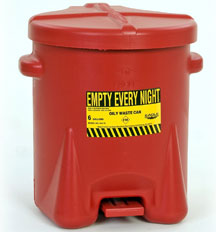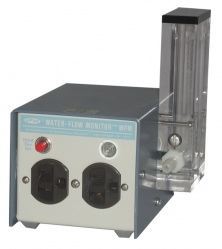



Find all of your laboratory and workplace safety supplies at Safety Emporium!
 ATSDR |
 Glossary Index |
 Base |
| MSDS Topics |
Free Sites | FAQ's | Regulations | Glossary | Software | Suppliers |
| Books | Forum | Poll | Fun stuff | Quiz | Store | |
| Understand your MSDS with the MS-Demystifier | Search ALL our MSDS info | |||||
The autoignition temperature or auto self-ignition temperature of a substance is the temperature at or above which a material will spontaneously ignite (catch fire) without an external spark or flame.

Get your oily waste and other safety cans from Safety Emporium.
Rags soaked with linseed oil are notorious for spontaneously (auto)igniting. The rags provide a high surface area for atmospheric oxygen to oxidize the hydrocarbon components, an exothermic (heat-releasing) chemical reaction. As the pile heats up, the rate of oxidation increases further until the temperature within the rag pile reaches the autoignition point. Such fires are unfortunately commonplace. For example, a 1991 fire started by the autoignition of 25 lbs of linseed oil-soaked rags gutted an office building and killed three firefighters.
Fire codes, therefore, require spontaneously combustible rags and other autoignitable materials to be stored in covered receptacles that limit oxidation and self-heating by excluding oxygen.
Other hydrocarbons such as turpentine, fish oil, lard etc. are also capable of autoignition. Always treat oily rags of any sort as a potential autoignition hazard. Rapid compression of some materials can also result in autoignition. For example, diesel engines do not use spark plugs to ignite the fuel-air mixture, but rather a rapid compression that raises the temperature to the autoignition point.
Autoignition temperatures are determined specialized equipment that is very similar to that used for flash point determinations.
Autoignition temperatures, are a required element on Safety Data Sheets and will be found on Section 9 (physical and chemical properties). If the term does not apply to the material (for example, a bag of cement can not autoignite), this should be listed as "not applicable (N/A)" or "none". However, note that HCS 2012 does not require testing, so the absence of a number does NOT mean the material lacks an autoignition temperature, it only means the company did not test the material or was too lazy to look up a value. Usually, such sheets will state "Not determined" or "N/D" for the autoignition temperature.
If an autoignition temperature is not listed, look for clues elsewhere on the sheet. Check Section 2 (Hazard(s) identifications) under Other Hazards. Examine Section 5 (fire-fighting measures) for comments under unusual fire/explosion hazards. Section 6 (accidental release measures) may also mention autoignition hazards. If you are suspicious of an unreported autoignition hazard on an SDS, consult SDS's for similar products from other manufacturers.
Storing a substance anywhere near its autoignition temperature is a severe safety hazard. Be careful storing substances in hot areas such as 1) sheds or cabinets exposed to direct sunlight, 2) adjacent to furnaces, hot water heaters or boilers or 3) places where flames or heat are often used.
Knowing a substance's autoignition temperature is also very useful in the event of a fire.

Mitigate hazards in the lab with temperature, voltage, and flow controllers from Safety Emporium.
See also: combustible, flash point
Additional definitions from Google and OneLook.
Entry last updated: Friday, March 18, 2022. This page is copyright 2000-2025 by ILPI. Unauthorized duplication or posting on other web sites is expressly prohibited. Send suggestions, comments, and new entry desires (include the URL if applicable) to us by email.
Disclaimer: The information contained herein is believed to be true and accurate, however ILPI makes no guarantees concerning the veracity of any statement. Use of any information on this page is at the reader's own risk. ILPI strongly encourages the reader to consult the appropriate local, state and federal agencies concerning the matters discussed herein.